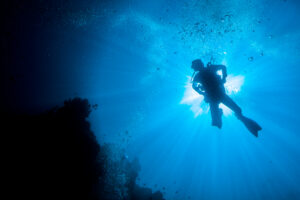What are the Bends?
Bends, also known as decompression sickness (DCS) or being bent, is a potentially serious condition that may affect scuba divers who ascend to the surface too rapidly or fail to follow proper decompression procedures. This article explores the symptoms, causes, prevention, and treatment of the bends, providing divers with essential knowledge to reduce the risk of DCS and maintain safe diving practices.
Decompression Sickness: Overview
Decompression sickness is a condition caused by dissolved nitrogen gas forming bubbles within the body tissues and bloodstream during or after a dive. The formation of these bubbles can lead to a range of symptoms, from mild discomfort to potentially life-threatening complications. The term “bends” originates from the characteristic bent posture divers may adopt due to joint pain caused by DCS. Decompression sickness is classified into two types:
Type I Decompression Sickness
This milder form of DCS is characterized by symptoms such as joint and muscle pain, skin itching, and rashes. These symptoms can be uncomfortable but are generally not life-threatening.
Type II Decompression Sickness
This severe form of DCS involves more critical symptoms that may affect the nervous system, respiratory system, or cardiovascular system. Symptoms can include paralysis, shortness of breath, chest pain, and even death in extreme cases.
Causes of the Bends
The primary cause of decompression sickness is the rapid release of dissolved nitrogen gas from body tissues during ascent. When a diver descends, the increased pressure causes nitrogen to dissolve into the blood and tissues. During ascent, this dissolved gas should gradually be released through the lungs, allowing the diver to safely return to the surface. However, if a diver ascends too quickly, nitrogen gas forms bubbles that can cause tissue damage, block blood flow, or exert pressure on nerves, leading to the various symptoms of DCS.
Risk Factors
Several factors can increase the risk of developing the bends, including:
Rapid ascent
Ascending to the surface too quickly is the primary cause of DCS. Divers should always follow recommended ascent rates and perform safety stops as necessary.
Deep or long dives
Greater depths and longer dive times increase the amount of dissolved nitrogen in the body, which in turn raises the risk of DCS.
Cold water
Cold water can constrict blood vessels, slowing the release of nitrogen gas and increasing the risk of bubble formation.
Dehydration
Proper hydration is essential for efficient nitrogen elimination. Dehydration can slow this process and increase the risk of DCS.
Pre-existing medical conditions
Certain medical conditions, such as cardiovascular disease, lung disorders, or obesity, may increase susceptibility to DCS.
Prevention
To prevent the bends, divers should adhere to the following safety guidelines:
Plan and execute dives carefully
Before each dive, plan the depth, time, and ascent rate. Monitor dive time and depth during the dive, and adhere to the planned ascent rates.
Follow decompression procedures
When diving beyond no-decompression limits, follow proper decompression procedures and use decompression tables or dive computers to ensure accurate ascent rates and decompression stops.
Stay hydrated
Drink plenty of water before and after diving to maintain proper hydration levels.
Avoid diving when ill or fatigued
Physical strain, illness, and fatigue can increase the risk of DCS. Dive only when in good physical and mental condition.
Wait before flying
To reduce the risk of DCS, wait at least 12-24 hours after a single dive or 18-48 hours after multiple dives before flying.
Treatment
If a diver suspects they are experiencing DCS, it is essential to seek prompt medical attention. Immediate first aid measures for suspected DCS include:
Administer oxygen
Provide the diver with 100% oxygen as soon as possible. This can help reduce the size of nitrogen bubbles and facilitate their elimination from the body.
Keep the diver horizontal
Laying the diver down horizontally can prevent further bubble formation and migration within the body.
Hydration
Encourage the diver to drink non-alcoholic, non-caffeinated fluids, such as water or electrolyte-replacement drinks, to help promote nitrogen elimination and combat dehydration.
Monitor the diver
Continuously assess the diver’s condition and symptoms, recording any changes or deterioration. This information can be critical for medical professionals in determining the appropriate course of treatment.
Emergency medical assistance
Contact emergency medical services or the nearest diving medical center and provide them with the diver’s symptoms, dive profile, and other relevant information. Transport the diver to a medical facility as soon as possible.
The primary treatment for DCS is recompression therapy, typically administered in a hyperbaric chamber. This treatment involves placing the affected diver in a pressurized environment that simulates the increased pressure experienced at depth. The increased pressure helps dissolve the nitrogen bubbles and allows for their gradual elimination through the lungs. In severe cases, additional treatments such as intravenous fluids, pain medication, or corticosteroids may be required.
Recovery and Long-Term Effects
The recovery time and prognosis for DCS vary depending on the severity of the condition and the speed of treatment. Mild cases of Type I DCS can resolve within hours or days with appropriate first aid and recompression therapy. More severe cases, particularly Type II DCS, may require more extended treatment and have a longer recovery period.
In some cases, DCS can lead to long-term complications or permanent damage, such as chronic joint pain, neurological damage, or pulmonary issues. It is crucial to seek immediate medical attention for suspected DCS to minimize the risk of lasting effects.
The bends, or decompression sickness, is a significant risk for scuba divers who ascend too quickly or fail to follow proper decompression procedures. Understanding the causes, symptoms, prevention, and treatment of DCS is essential for all divers to ensure their safety and well-being during and after dives. By adhering to safe diving practices and being aware of potential risk factors, divers can significantly reduce their risk of developing the bends and continue to explore the underwater world with confidence.
















